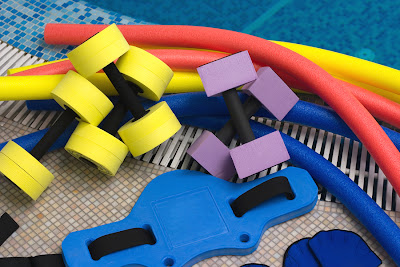According to the Aquatic Exercise Association there are five types of
equipment that professionals can incorporate into their aquatic programmes. All
professionals should know the proper use of equipment, which means
understanding the function, purpose, limitations, properties, safety factors,
and biomechanics of the equipment.
Aquatic equipment is divides into five general categories:
- Buoyant equipment. This equipment is comprised of a material that floats in the water, or is filled with air. This type of equipment can create a great deal of resistance in the water because it interacts with the forces of buoyancy. Any movement toward the bottom of the pool is buoyancy resisted and is usually a concentric muscle action. Any movement toward the surface of the water is buoyancy assisted and is usually an eccentric muscle action. Equipment like hand bars, cuffs, and balls belong in this equipment type.
- Weighted equipment. Muscle action for weighted resistance in the water is very similar to land. It sinks in the water and is influenced by the forces of gravity. Any movement performed upward against the forces of gravity is gravity resisted and usually creates a concentric muscle action. The movements that are performed downward are assisted by the forces of gravity and usually create an eccentric muscle action. This type of equipment and the buoyed equipment complement each other well in programming as it is easier to work certain muscles with buoyant equipment and others with weighted equipment. Ankle weights and dumbbells are an excellent example of weighted equipment.
- Drag equipment. This type of equipment satisfies the muscle balance equation more simply than if using weighted or buoyant resistance. The muscle equation becomes the same as the equation for moving in the water without equipment; however, the resistive force has been magnified. Drag equipment can be cumbersome and may actually reduce the potential for full range of motion due to the increased surface area. Gloves, paddles, and Speedo’s hydro resistant leg and arm trainers belong in this category.
- Rubberized equipment. The muscle action created by this type of equipment is virtually the same regardless of the environment. Any muscle action away from the anchored point is resisted and concentric. Many types of rubberized equipment have been created, including bands and tubes with handles, straps, and ways to anchor the equipment with your own body or some outside source. Keep in mind that this type of equipment will break down from exposure to the pool chemicals and sunlight and must be inspected frequently to assure the safety of participants.
- Flotation equipment. This type of equipment is used to create neutral buoyancy and not to increase resistance. Participants should use a flotation belt to help maintain vertical alignment in deep water exercise. It can be used together with buoyant equipment. Participants and professionals should avoid using buoyant equipment as flotation equipment because it can affect positioning in the water.
Image source: [1]






No comments:
Post a Comment